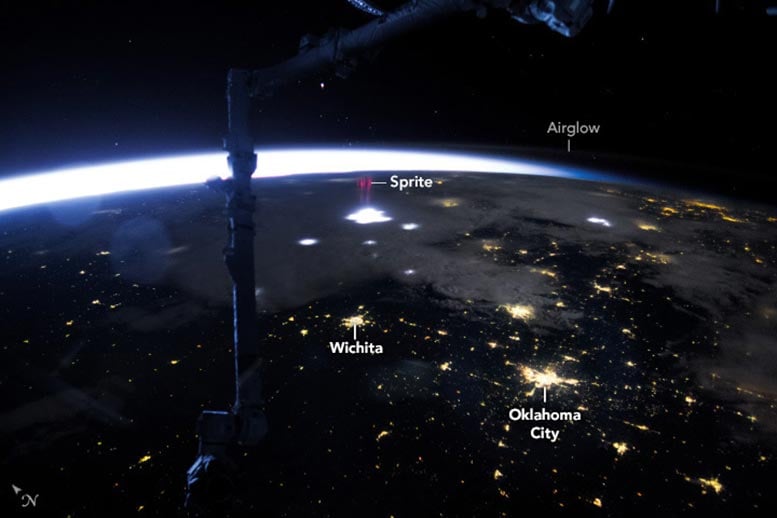
https://earthobservatory.nasa.gov/images/153422/sprites-camera-action
An astronaut on the International Space Station captured a red sprite over North America, a rare atmospheric phenomenon associated with powerful lightning.
This event, visible from space, was recorded through a timelapse video that spans over several U.S. states. The sequence also highlights other weather phenomena and contributes to NASA’s Spritacular project, which aims to better understand these elusive events.
Capturing the Elusive: Red Sprites From Space
An astronaut aboard the International Space Station (ISS) captured a sequence of photos showcasing a red sprite, a rare atmospheric phenomenon linked to lightning, over North America. Storm clouds shrouded the nighttime city lights of the U.S. Midwest and South. The space station’s Canadarm2 robotic arm is visible as a dark, elongated feature at the center of the sequence.
Timelapse From Orbit: A Glimpse of Earth’s Dynamic Weather
Timelapse videos captured from the station are created by shooting a long sequence of photographs at short intervals. The images are stitched together, using approximately 25 to 29 frames per second, to create a video that showcases thousands of miles of Earth within just a few minutes. This trimmed timelapse spans 19 seconds and provides views of northern Mexico and southern and midwestern U.S. states, and ends as the station approaches the Great Lakes and western Canada.
Atmospheric Phenomena: Unveiling the Mysteries of Sprites
Flashes of lightning illuminate the storm system and produce one large sprite, visible to the right of the Canadarm2 at 15 seconds into the video (above) and in the photo (below). Sprites—an atmospheric phenomenon associated with powerful lightning events—occur in the mesosphere. This layer of the atmosphere is about 50-85 kilometers (31-53 miles) above Earth’s surface, far higher than the tops of cumulonimbus clouds associated with thunderstorms.
Advancing Science From Above: NASA’s Study of Transient Luminous Events
The ISS provides a unique vantage point above weather systems that allows observations of cloud tops and associated atmospheric phenomena, such as sprites and other transient luminous events (TLEs). Sprites appear to be connected to positively charged cloud-to-ground lightning strokes. The positively charged lightning interacts with atmospheric nitrogen, creating an electrical breakdown that produces flashes of red light. The sprite in this photograph has red tendrils associated with jellyfish sprites.
Challenges and Contributions: Documenting Sprites
Sprites can be challenging to photograph. The night sky must be clear of clouds to capture a sprite on camera from Earth’s surface. An astronaut on the space station will set up a camera in the Cupola to take a timelapse sequence using a short focal length lens, such as the 28-millimeter lens used in this sequence. The short focal length allows for quick sequential photographs with a broader field of view, increasing the chances of documenting the phenomena. NASA’s Citizen Science Project, Spritacular, is building a database to host imagery of sprites and TLEs.
Astronaut photograph ISS071-E-234765 was acquired on June 26, 2024, with a Nikon Z9 digital camera using a focal length of 28 millimeters. The image was captured during the acquisition of timelapse ISS071-230987-234857. It is provided by the ISS Crew Earth Observations Facility and the Earth Science and Remote Sensing Unit, Johnson Space Center. The timelapse was taken by a member of the Expedition 71 crew. The image has been cropped and enhanced to improve contrast, and lens artifacts have been removed. The International Space Station Program supports the laboratory as part of the ISS National Lab to help astronauts take pictures of Earth that will be of the greatest value to scientists and the public, and to make those images freely available on the Internet.